Brother P-TOUCH 7500, P-TOUCH 7600 User Manual
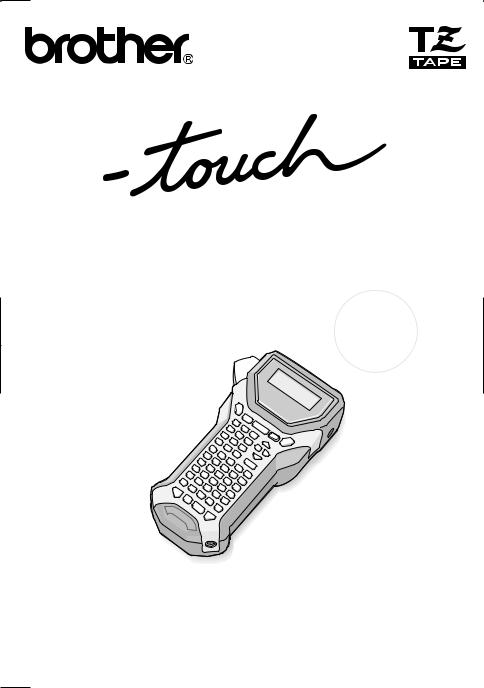
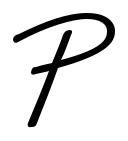 7500/7600
7500/7600
USER´S GUIDEI
•Read this User’s Guide before you start using your P-touch.
•Keep this User’s Guide in a handy place for future reference.
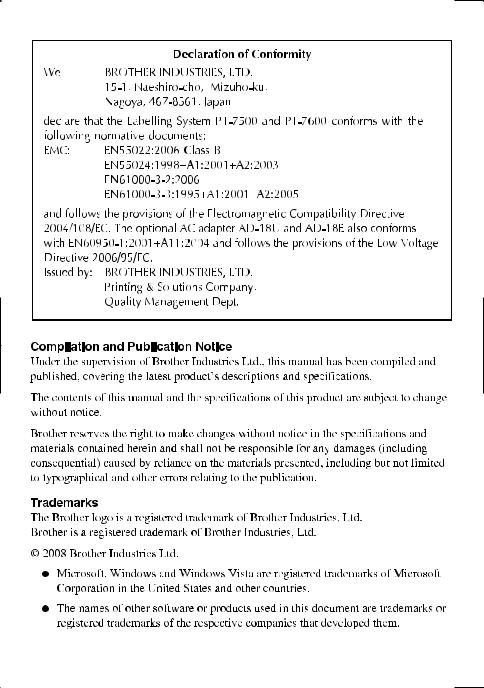

Before Using Your P-touch
Thank you for purchasing the PT-7500/7600.
Your new P-touch is an easy to operate, feature packed labelling system that makes creating professional, high quality labels a breeze. In addition to easy label creation via pre-formatted label layouts, the P-touch editing software features advanced label formatting, block formats, bar codes and auto-numbering functions.
Safety precautions
To prevent injury and damage, important notes are explained using various symbols. The symbols and their meanings are as follows:
WARNING |
Tells you what to do to avoid the risk of injury. |
|
|
CAUTION |
Tells you about procedures you must follow to prevent damage to the P-touch. |
|
|
The symbols used in this manual are as follows:
|
Action NOT allowed. |
|
DO NOT disassemble the product. |
|
|
|
|
|
DO NOT splash the product with or |
|
DO NOT touch this part of the product. |
|
immerse the product in water. |
|
|
|
|
|
|
|
|
|
|
|
Mandatory action |
|
Unplugging |
|
|
|
|
|
Safety alert |
|
Alerts to the possibility of electrical |
|
|
shock |
|
|
|
|
|
|
|
|
|
i
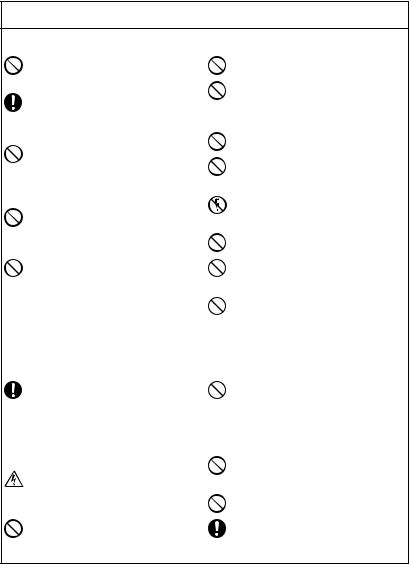
 WARNING
WARNING
Rechargeable battery pack (for PT-7600 only)
Follow these guidelines to avoid fire, heat, damage, and electric shock.
Do not use this P-touch with any rechargeable battery pack other than that specified.
To recharge the rechargeable battery pack, insert the rechargeable battery pack into the P-touch, and then use AD-18U or AD-18E designed specifically for this P-touch.
Do not insert or use the rechargeable battery pack in any equipment other than the P- touch. Do not directly connect it to a power supply, car cigarette lighter or electrical outlet.
Do not expose the rechargeable battery pack or the P-touch with the rechargeable battery pack installed to pressure, heat, electric charge or microwaves.
Do not place the rechargeable battery pack or the P-touch with the rechargeable battery pack installed near a fire or in a location exposed to heat or high temperatures (for example, near a flame or stove, in the sun, or in a location where the temperature is 60 °C or more, such as in a hot car).
Do not allow the rechargeable battery pack to get wet.
Do not short-circuit the terminals of the rechargeable battery pack or the P-touch with the rechargeable battery pack installed, such as with a metal object.
Do not pierce the external casing of the rechargeable battery pack in any way. Take care to prevent damage to the rechargeable battery pack, or the P-touch
with the rechargeable battery pack installed. Do not disassemble or alter the rechargeable battery pack or the P-touch with the rechargeable battery pack installed.
Do not use a damaged or deformed rechargeable battery pack.
Do not use in a corrosive environment (for example, exposed to salty air or salt water, or acidic, alkaline or corrosive gas).
Do not insert or remove the rechargeable battery pack when the AC adapter is connected.
AC adapter
Follow these guidelines to avoid fire, damage, electric shock, or failure.
Use only the AC adapter (AD-18U or AD18E) designed exclusively for your P-touch. Failure to observe this may result in an accident or damage. Brother shall not assume any responsibility for any accident or damage resulting from not using the specified AC adapter.
Unplug the power cord immediately and stop using the machine during an electrical storm. There may be a remote risk of electric shock from lightning.
Do not touch the AC adapter or power plug with wet hands.
Do not use the AC adapter in places of high humidity such as bathrooms.
 Do not use a damaged power cord.
Do not use a damaged power cord.
 Do not overload the power outlet.
Do not overload the power outlet.
Do not place heavy objects on, damage or modify the power cord or plug. Do not forcibly bend or pull the power cord.
Do not drop, hit or otherwise damage the AC adapter.
Make sure that the plug is fully inserted in the power outlet. Do not use an outlet that is loose.
ii
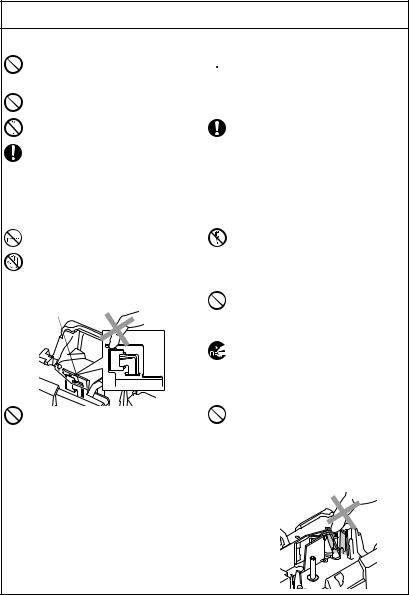
 WARNING
WARNING
Batteries (Alkaline/Rechargeable)
Follow these guidelines to avoid leakage, or damage to the batteries.
Do not use metallic articles, such as tweezers or a metallic pen, when exchanging the batteries.
Do not charge the batteries in high temperature locations.
Do not throw into fire, heat up, or disassemble the battery.
If battery fluid comes into contact with skin or clothes, wash the affected areas thoroughly with clean water. Battery fluid is harmful to skin.
 If the batteries leak, make sure the fluid does not come into contact with your eyes, as this may result in loss of eyesight. If contact does occur, flush eyes with clean water and seek medical attention urgently.
If the batteries leak, make sure the fluid does not come into contact with your eyes, as this may result in loss of eyesight. If contact does occur, flush eyes with clean water and seek medical attention urgently.
If the batteries begin to emit an odour, overheat, discolour, deform, or any other change occurs during use, charging, or storage, remove the batteries immediately and discontinue use.
P-touch
Follow these guidelines to avoid fire, damage, electric shock, and choking.

 Do not allow the P-touch to get wet in any way.
Do not allow the P-touch to get wet in any way.
Do not touch any metal parts near the print head. The print head becomes very hot during use and remains very hot immediately after use. Do not touch it directly with your hands.
Print head
Do not use the P-touch with a foreign object in it. If water, metallic substance or any foreign object enters the P-touch, disconnect the AC adapter and remove battery, and contact the retail outlet where the P-touch was purchased or your local authorized service centre.
 Do not touch the blade of the cutter unit.
Do not touch the blade of the cutter unit.
Do not disassemble the P-touch. For inspection, adjustment, and repair of the P- touch, contact the retail outlet where the P- touch was purchased or your local authorized service centre.
Plastic bags are used in the packaging of your machine. To avoid danger of suffocation, keep these bags away from babies and children.
Disconnect the AC adapter and remove battery immediately and stop using when you notice abnormal odour, heat, discolouration, deformation or anything unusual while using or storing it.
To prevent damage, do not drop or hit the machine.
iii
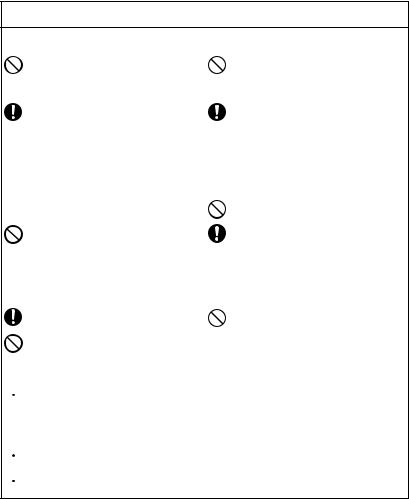
 CAUTION
CAUTION
Tape Cutter
Follow these guidelines to avoid personal injury and damage of the P-touch.
Do not open the tape compartment cover when operating the cutter unit.
AC adapter
Do not apply excessive pressure to the cutter unit.
If you do not intend using the P-touch for an extended period of time, please disconnect the AC adapter from the power outlet and the P-touch to avoid battery leakage or loss of charge.
Always hold the plug when disconnecting the power cord from the power outlet.
Batteries
Follow these guidelines to avoid liquid leakage, heat or rupture of the batteries.
 Do not use old and new batteries together.
Do not use old and new batteries together.
Do not mix alkaline batteries with other type batteries.
 Do not let the batteries get wet.
Do not let the batteries get wet.
Check that the batteries are correctly inserted.
If you do not intend using the P-touch for an extended period of time, please remove the battery to avoid battery leakage or loss of charge.
P-touch
Follow these guidelines to avoid personal injury and damage of the P-touch.
Place the P-touch on a flat, stable surface such as a desk.
Do not leave the P-touch within reach of children with the back cover open.
Tape
Do not place any heavy objects on top of the P-touch. Do not press on the LCD screen.
 Depending on the location, material, and environmental conditions, the label may unpeel or become irremovable, the colour of the label may change or be transferred to other objects. Before applying the label, check the environmental condition and the material.
Depending on the location, material, and environmental conditions, the label may unpeel or become irremovable, the colour of the label may change or be transferred to other objects. Before applying the label, check the environmental condition and the material.
Memory
 Any data stored in memory will be lost due to failure or repair of the P-touch, or when the batteries expires and the power is disconnected.
Any data stored in memory will be lost due to failure or repair of the P-touch, or when the batteries expires and the power is disconnected.
 When power is disconnected for more than two minutes, all text and format settings will be cleared. Any text files stored in the memory will also be cleared.
When power is disconnected for more than two minutes, all text and format settings will be cleared. Any text files stored in the memory will also be cleared.
iv
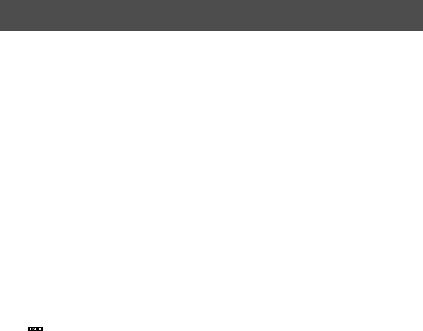
General Precautions
●Do not use the P-touch in any way or for any purpose not described in this guide. Doing so may result in accidents or damage to the machine.
●Do not put any foreign objects into the tape exit slot, AC adapter connector, or USB port (for PT-7600 only), etc.
●Do not touch the print head with your fingers. Use a soft wipe (e.g. a cotton swab) when cleaning the print head or the optional print head cleaning cassette (TZ-CL4) when cleaning the print head.
●Do not clean the machine with alcohol or other organic solvents. Only use a soft, dry cloth.
●Do not place the P-touch/battery in direct sunlight or rain, near heaters or other hot appliances, in any location exposed to extremely high or low temperatures (e.g. on the dashboard or in the back of your car), high humidity, or dusty locations.
Standard operating temperature range: 10°C to 35°C.
●Do not leave any rubber or vinyl on the machine for an extended period of time, otherwise the machine may be stained.
●Depending on the environmental conditions and the applied settings, some characters or symbols may be difficult to read.
●Use only Brother TZ tapes with this machine. Do not use tapes that do not have the
 mark.
mark.
●Do not pull or apply pressure to the tape in the cassette. Otherwise the tape cassette or P-touch may be damaged.
●Make sure that the release lever is up when closing the back cover. The back cover cannot be closed if the release lever is pressed down.
●Do not try to print labels using an empty tape cassette or without a tape cassette set in the P-touch. Doing so will damage the print head.
●Do not attempt to cut tape while printing or feeding since this will damage the tape.
●It is recommended that you use the USB cable supplied with the P-touch. Should another USB cable need to be used, ensure it is of high quality construction (for PT-7600 only).
●Be careful not to scratch the CD-ROM. Do not place the CD-ROM in any location exposed to high or low temperatures. Do not place heavy objects on the CD-ROM or bend it (for PT-7600 only).
●The software on the CD-ROM is intended for use with the P-touch and may be installed on more than one PC (for PT-7600 only).
●We strongly recommend that you read this User's Guide carefully before using your P-touch, and then keep it nearby for future reference.
v
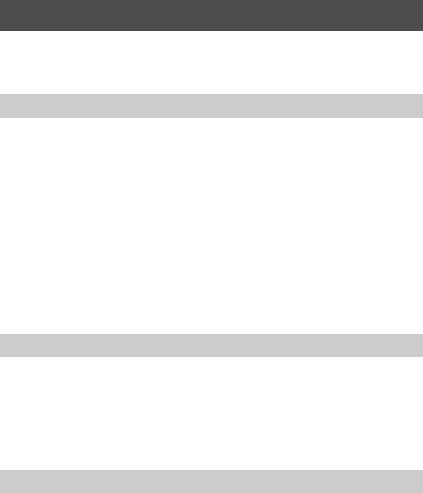
Contents |
|
Before Using Your P-touch ............................................................. |
i |
Safety precautions .......................................................................................... |
i |
General Precautions ...................................................................... |
v |
1. Getting Started .............................................................. |
1 |
Unpacking Your P-touch ............................................................... |
1 |
General Description ...................................................................... |
3 |
Top view & bottom view ............................................................................... |
3 |
Keyboard & LCD screen .............................................................................. |
4 |
Back light ...................................................................................................... |
5 |
Power Supply ................................................................................. |
5 |
AC Adapter ................................................................................................... |
5 |
Batteries ........................................................................................................ |
6 |
Rechargeable battery pack (for PT-7600 only) ............................................ |
7 |
Tape Cassettes ............................................................................... |
9 |
Installing a tape cassette ............................................................................... |
9 |
Turning the P-touch On/Off ........................................................ |
12 |
Changing the Language ................................................................ |
12 |
2. Label Type Modes ........................................................ |
13 |
Selecting a Label Type Mode ....................................................... |
13 |
Normal and Vertical Modes ......................................................... |
13 |
Rotate and Rotate & Repeat Modes ............................................. |
14 |
Flag Mode .................................................................................... |
15 |
Port and Panel1 Modes ................................................................ |
16 |
Panel2 Mode ................................................................................ |
17 |
3. Basic Functions ............................................................ |
19 |
Performing Basic Operations ....................................................... |
19 |
Choosing functions, parameters, settings and groups ................................ |
19 |
Choosing the default setting ....................................................................... |
19 |
Confirming a choice .................................................................................... |
19 |
Cancelling a choice .................................................................................... |
19 |
Inputting Label Data .................................................................... |
20 |
Entering and editing text ............................................................................. |
20 |
vi

Entering an accented character .................................................................. |
22 |
Entering a bar code .................................................................................... |
23 |
Entering a symbol ....................................................................................... |
25 |
Formatting the Label .................................................................... |
28 |
Specifying a label length ............................................................................. |
28 |
Specifying a margin size ............................................................................. |
28 |
Framing the text .......................................................................................... |
29 |
Specifying the character size ...................................................................... |
30 |
Specifying the character width ................................................................... |
31 |
Specifying the character style ..................................................................... |
32 |
Using the pre-formatted Auto Format templates ........................................ |
33 |
Printing Labels ............................................................................. |
34 |
Previewing the label layout ........................................................................ |
34 |
Feeding tape ............................................................................................... |
35 |
Printing a label ........................................................................................... |
35 |
Using special printing functions ................................................................. |
35 |
Storing and Recalling Files ........................................................... |
39 |
Storing label text ......................................................................................... |
39 |
Recalling text that has been stored ............................................................. |
40 |
Deleting text that has been stored ............................................................... |
40 |
4. Machine Adjustments .................................................. |
42 |
Selecting how tape is fed and cut ................................................................ |
42 |
Adjusting the display contrast ..................................................................... |
42 |
Using the Auto Reduction function ............................................................. |
43 |
Calibrating the label length ........................................................................ |
43 |
Updating the PERSONAL symbol category .............................................. |
44 |
Changing the units of measure ................................................................... |
44 |
Displaying version information .................................................................. |
44 |
Cleaning ...................................................................................... |
45 |
Cleaning the print head, rollers and tape cutter ........................................ |
45 |
5. Using P-touch With a Computer (for PT-7600 only) ...47
Installing the Software & Printer Driver ...................................... |
47 |
Introduction ................................................................................................ |
47 |
System requirements ................................................................................... |
48 |
Installing P-touch Editor 5.0 and the Printer driver .................................. |
48 |
Uninstalling P-touch Editor 5.0 .................................................................. |
53 |
Uninstalling / Replacing the printer driver ................................................ |
53 |
vii

Using P-touch Editor 5.0 .............................................................. |
54 |
Starting P-touch Editor ............................................................................... |
55 |
Layout window ............................................................................................ |
57 |
Starting P-touch Editor Help ...................................................................... |
59 |
Transferring Data To/From a Computer ...................................... |
61 |
Entering Transfer mode .............................................................................. |
61 |
How to use P-touch Transfer Manager & P-touch Library ........... |
62 |
Starting up P-touch Transfer Manager ...................................................... |
62 |
Transferring label templates from the PC .................................................. |
64 |
Adding a user-defined character image to the text ..................................... |
66 |
Using template data .................................................................................... |
66 |
Using downloaded database data ............................................................... |
68 |
Backing up label templates ......................................................................... |
70 |
Starting up the P-touch Library .................................................................. |
72 |
Searching labels .......................................................................................... |
72 |
6. Appendix ..................................................................... |
74 |
Resetting the P-touch ................................................................... |
74 |
Troubleshooting ........................................................................... |
74 |
Error Message List ........................................................................ |
76 |
Machine Specifications ................................................................ |
81 |
Main Unit .................................................................................................... |
81 |
Operating Environment: Windows® (for PT-7600 only) ........................... |
83 |
Accessories .................................................................................. |
83 |
Index ........................................................................................... |
88 |
viii
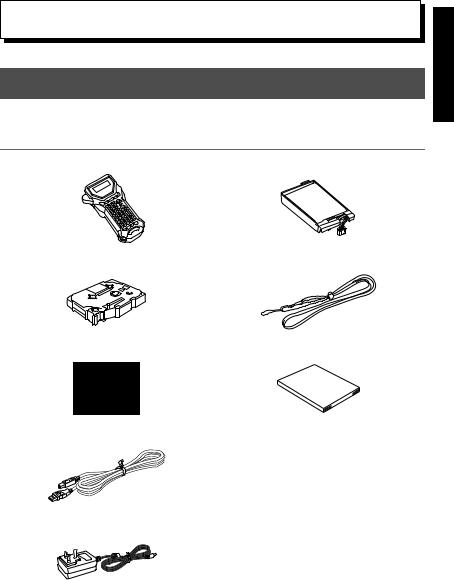
1 Getting Started
Unpacking Your P-touch
Check that the package contains the following before using your P-touch.
Rechargeable battery pack (BA-7000)
Strap belt
User's Guide
Getting Started
1
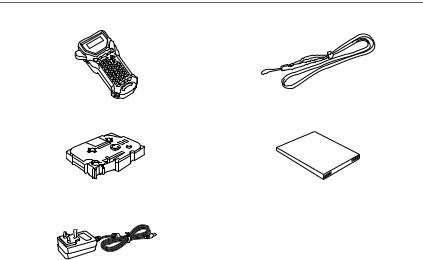
PT-7500
P-touch |
Strap belt |
TZ tape cassette |
User's Guide |
AC adapter (AD-18U or AD-18E)
(The design of the adapter may differ by country.)
2
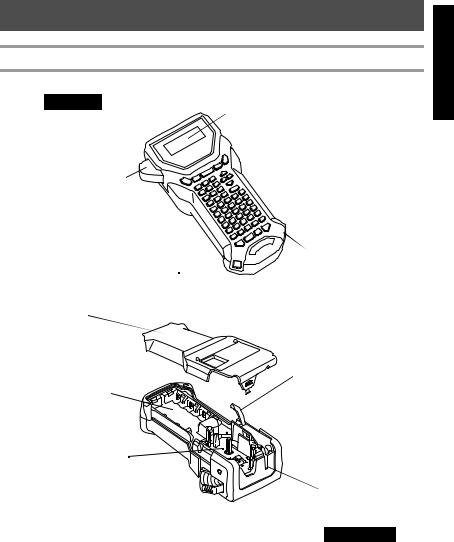
General Description
Top view & bottom view
Top view
 Display
Display
Tape cutter button 
Keyboard 

AC adapter connector
USB port  (for PT-7600 only)
(for PT-7600 only)
Back cover
Release lever
Battery compartment
Print head
Tape cassette compartment
 Tape exit slot
Tape exit slot
Bottom view
Getting Started
3
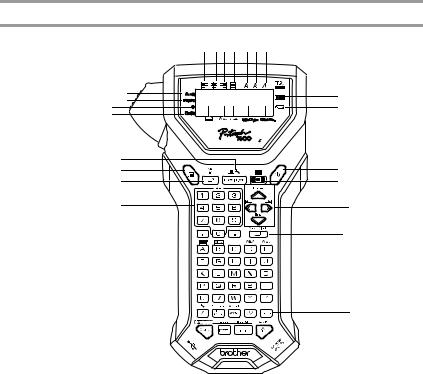
Keyboard & LCD screen
PT-7600 is shown here.
E
G F
H
Q
P
O
N
1 234 567 |
|
||
D CB A |
0 |
8 |
|
9 |
|||
|
|
||
I
J
K
L
M
1 Left text alignment (page 33)
2 Centre text alignment (page 33)
3 Right text alignment (page 33)
4 Justified text alignment (page 33)
5 Bold text style (page 32)
6 Outline text style (page 32)
7 Italic text style (page 32)
8 Frame (page 29)
9 Low battery indicator (page 7)
0 Block number (page 21)
A Label Type setting (page 13) B Width setting (page 31)
C Size setting (pages 30 & 31) D Length setting (page 28)
E Caps mode (page 20) F Insert mode (page 21) G Shift mode (page 20) H Code mode (page 20) I Power key (page 12)
JBackspace key (pages 19 & 22)
K Arrow keys (page 19)
L Return key (pages 19 & 21) M Global format key (page 30)
NPF keys (page 33) (PT-7600) Auto Format keys (page 33) (PT-7500)
O Feed key (page 35) P Print key (page 35) Q Label Type (page 13)
4
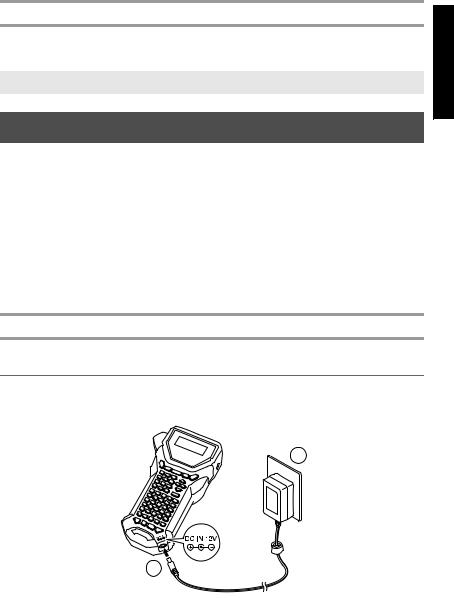
Back light
Press gand fto turn on or turn off the back light. The back light can be used when you wish to see the display more clearly. The default setting is ON.
Power can be saved when the back light is turned off.
Power Supply
The P-touch can be supplied with two or three power supply options.
|
AC adapter |
Batteries |
Rechargeable battery pack* |
|
(page 5) |
(page 6) |
(page 7) |
|
|
|
|
PT-7500 |
● |
● |
- |
|
|
|
|
PT-7600 |
● |
● |
● |
*The rechargeable battery pack is a consumable product. There is no guarantee against its deterioration during storage.
Use the power supply best suited to your needs. For details on each power supply, refer to the following description below.
Getting Started
AC Adapter
Connecting the AC adapter
When printing a large number of labels or labels that contain a large amount of text, it may be useful to connect the P-touch to a standard electrical outlet using the AC adapter.
5
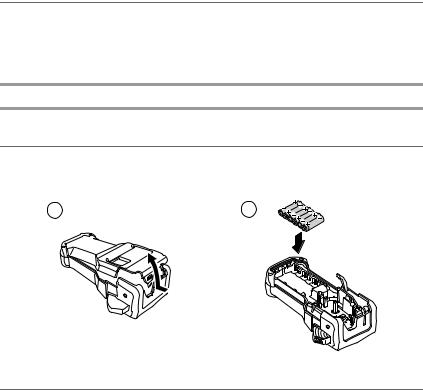
Notes on the AC adapter
Only use the AC adapter designed exclusively for this machine.
Disconnect the AC adapter if you do not intend to use this P-touch for an extended period of time. When the power is disconnected, all text shown in the display and stored in the memory will be lost.
Batteries
Installing the batteries
This machine has been designed to allow you to change the batteries quickly and easily. With batteries installed, this compact and portable machine can be used anywhere.
1 |
2 |
Notes on batteries
This P-touch requires six AA-size batteries (LR6). Rechargeable (Ni-MH) batteries can be used instead of six alkaline batteries.
The rechargeable batteries cannot be recharged by leaving them in the P-touch with the AC adapter connected. Instead, recharge the rechargeable batteries by using a battery charger designed specifically for the type of rechargeable batteries used. For more details on the rechargeable batteries, refer to the instructions provided with them.
Do not use any of the following, otherwise battery leakage or damage may occur.
•Manganese batteries
•A combination of new and used batteries
•A combination of batteries of different types (alkaline and Ni-MH), different manufacturers or different models
•A combination of recharged and uncharged batteries
6
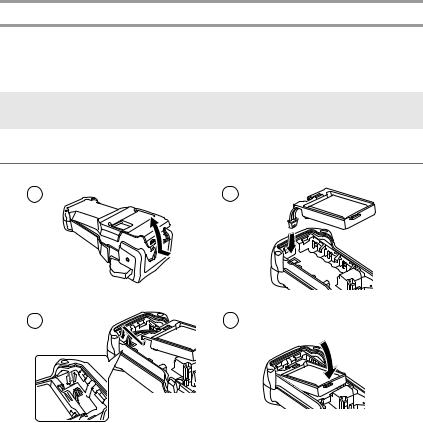
Make sure that the batteries are inserted so that their poles point in the correct direction. |
|
||
|
With batteries installed, the P-touch determines the remaining battery charge during |
Started |
|
|
printing and feeding. If a low battery charge is detected, the low battery indicator ()) |
||
|
|
||
|
comes on. When this occurs, be sure to replace the batteries. The low battery indicator |
|
|
|
may not come on in some operating conditions. |
Getting |
|
|
Before replacing the batteries, make sure that the P-touch is turned off. In addition, when |
||
|
|||
|
replacing the batteries, insert the new ones within two minutes of removing the old ones, |
|
|
|
otherwise the text shown in the display and any text stored in the memory will be lost. |
|
|
If you do not intend to use this P-touch for an extended period of time, remove the |
|
||
|
batteries. When the power is disconnected, all text shown in the display and stored in the |
|
|
|
memory will be lost. |
|
|
Rechargeable battery pack (for PT-7600 only)
The machine has a rechargeable battery pack that allows you to use it anywhere when charged, and an AC adapter that allows you to use it while connected to an electrical outlet when the rechargeable battery pack’s charge becomes low.
If you do not use the rechargeable battery pack frequently, you can increase its useable life by charging it every six months.
Installing the rechargeable battery pack
1 |
2 |
3 |
|
7
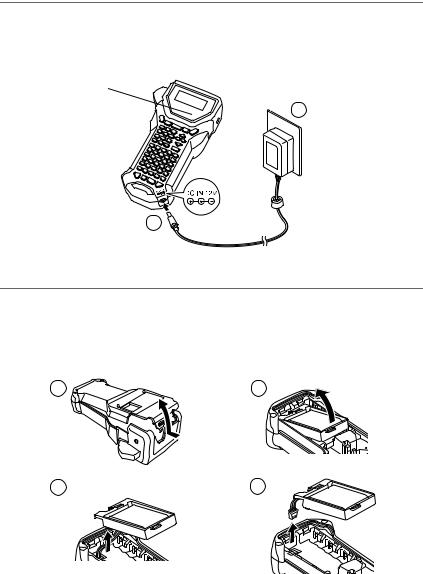
Charging the rechargeable battery pack
Insert the plug on the AC adapter cord into the connector on the machine and insert the AC adapter plug into a standard electrical outlet. While the rechargeable
battery pack is charging, the charging indicator light lights up. Charging time is approx. 3 hours. The charging indicator light turns off when charging is completed.
Charging indicator light
Replacing the rechargeable battery pack
If you use your P-touch frequently, you will generally need to replace the rechargeable battery pack after approximately one year. While the replacement period varies depending on the conditions of use, you should replace the pack when it shows signs of holding a reduced charge. Be sure to replace it with the specified rechargeable battery pack (BA-7000).
1 |
2 |
8
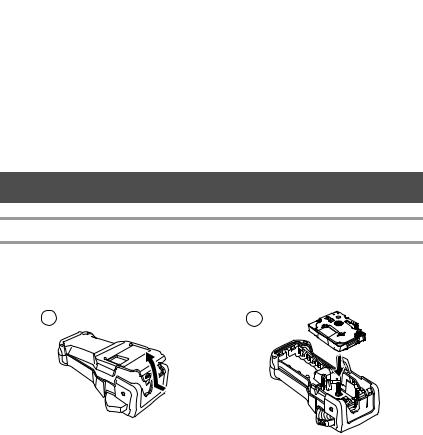
Notes on the rechargeable battery pack |
|
|
|
|
|||
Be sure to use the suggested AC adapter (AD-18U or AD-18E) |
Started |
||
Connect the AC adapter directly to the P-touch to use it immediately after purchase or |
|||
|
|||
when the rechargeable battery pack’s charge becomes low. |
|
||
Disconnect power to the P-touch when installing or removing the rechargeable battery |
Getting |
||
Be sure to charge the rechargeable battery pack before using the P-touch. |
|||
pack. |
|
||
The rechargeable battery pack may not be charged sufficiently when the power supply is |
|
||
less than the rated voltage. |
|
||
|
|||
Be sure to charge the new rechargeable battery pack for 3 hours after replacement. |
|
||
Be sure to dispose of the expired rechargeable battery pack as directed by local |
|
||
regulations for the disposal of nickel metal hydride batteries. |
|
||
Tape Cassettes
Installing a tape cassette
This machine has been designed to allow you to change the tape cassettes quickly and easily. TZ tape cassettes are available for this machine in a wide variety of types, colours and sizes, enabling you to make distinctive colour-coded and stylized labels.
1 |
2 |
9
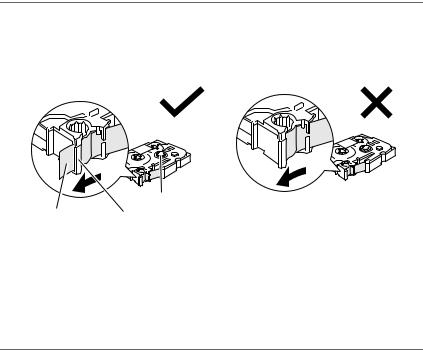
Notes on tape cassettes
Before installing the tape cassette, make sure that the end of the tape feeds under the tape guides.
If the tape cassette to be installed has an ink ribbon and the ink ribbon is loose, use your finger to wind the toothed wheel in the direction of the arrow on the cassette until there is no slack in the ribbon.
Toothed wheel
End of the tape |
Tape guide |
When inserting the tape cassette, make sure that the inner ribbon does not catch on the corner of the metal guide.
After installing a tape cassette, press fonce to remove any slack in the tape, and then press the tape cutter button to cut off the excess tape.
Always cut off the tape before removing it from the machine. If the tape is pulled on before being cut off, the tape cassette may be damaged.
Strong Adhesive Tape
For textured, rough, or slipping surface, we recommend using Strong Adhesive Tape.
Although the instruction sheet included with the Strong Adhesive Tape cassette recommends cutting the tape with scissors, the tape cutter that this P-touch is equipped with is able to cut Strong Adhesive Tape.
10
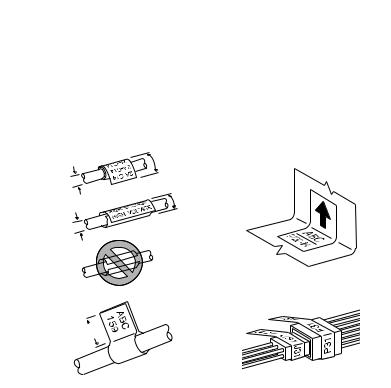
Flexible ID Tape |
|
|
|
|
|||
For applications that require more flexible labels, such as around sharp bends and |
Started |
||
cylindrical objects, we recommend using Flexible ID Tape. |
|||
|
|||
Labels made with Flexible ID Tape are not designed for use as electrical insulation. |
|
||
When wrapping labels around cylindrical objects, the diameter of the object should be at |
Getting |
||
mode should be used. In addition, the overlapping ends of the label or the label flag |
|||
least 3 mm, otherwise the label should be wrapped as a flag and the FLAG Label Type |
|
||
should be at least 5 mm. |
|
||
The label may peel off cylindrical objects if the object is bent after the label is affixed. |
|
||
|
|||
Overlap > 5 mm
Diameter > 3 mm
Overlap > 5 mm
Diameter > 3 mm
Flag > 5 mm 
11

Turning the P-touch On/Off
Press o to turn on or turn off the P-touch.
If the P-touch is powered by the AC adaptor or batteries, the previous session’s text is displayed when the P-touch is turned on again. This feature allows you to stop work on a label, turn off the machine, and return to it later without having to re-enter the text.
Regardless of whether the P-touch is being operated from battery or the AC adapter, the machine will automatically turn off if no key is pressed or no operation is performed for 5 minutes.
Changing the Language
The language of the menus, settings and messages can be changed by selecting
ENGLISH, FRANÇAIS, ESPAÑOL, PORTUGUÊS, DEUTSCH, NEDERLANDS, ITALIANO, DANSK, SVENSKA, NORSK, or SUOMI. (The default setting is ENGLISH.)
1Press g, then Z.
2Press l or r until LANGUAGE is displayed.
3Press u or d until the desired setting is displayed, and then press n.
12

2 Label Type Modes
Selecting a Label Type Mode
Pressing aallows you to select one of the two regular modes for designing and printing your own custom labels, or any of the six special modes available for printing labels preformatted for identifying patch panels, cables, connectors and other components.
1Press a.
2Press u or d (or continue pressing a) until the desired mode is displayed. (For details on each Label Type mode, refer to the sections below.)
3Press n to apply the selected Label Type mode.
•If NORMAL or VERTICAL was selected, continue entering the label text as described in chapter 3, Basic Functions.
•If ROTATE, R & REP., PORT, PANEL1, PANEL2 or FLAG was selected, continue with the following steps.
4Press l or r until the desired parameter is displayed.
5Press uor d until the desired setting is displayed (or use the number keys to type in the desired setting).
6Press n to apply the selected settings.
7Type the text for each label in a separate text block.
8Print the labels.
•To print a single copy of each label, press p.
•To print multiple copies or several copies while increasing certain characters, or to print using any other special printing function, press g, then aand choose
your options. (For details, refer to Using special printing functions on page 35.)
Normal and Vertical Modes
Labels printed using the Normal and Vertical Label Type modes can be formatted and printed to fit any need.
NORMAL
ABCDE
VERTICAL
A B C D E
Label Type Modes
13
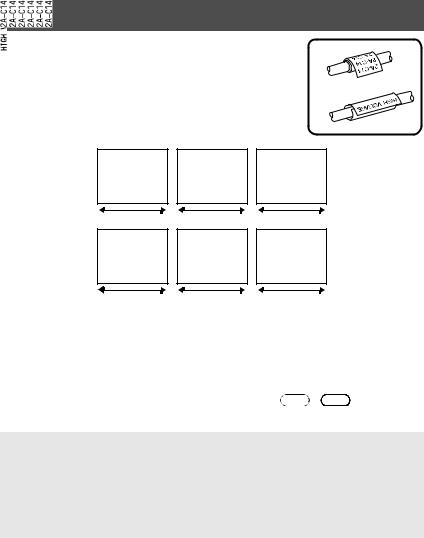
After selecting the Label Type mode NORMAL or VERTICAL, the label text can be entered, formatted, printed and cut as usual. With the Normal Label Type mode, the entered text is printed horizontally along the label. With the Vertical Label Type mode, the entered text is printed vertically along the label.
Rotate and Rotate & Repeat Modes
Labels printed using these Label Type modes can be wrapped around cables and wires to mark them. With both of these modes, the text is rotated 90° anti-clockwise and each text block printed on a separate label as shown below. With the Rotate & Repeat mode, the text is printed repeatedly along the length of the label so that it can easily be read from any angle.
Rotate
 Block length
Block length
 Block length
Block length
 Block length
Block length 
Rotate
&
Repeat
Block length
 Block length
Block length
 Block length
Block length
After selecting the ROTATE or R & REP. Label Type mode, specify the length of each label and a frame style if desired.
● BL. LEN. (block length): 20.0 to 200.0 mm Default: 30.0 mm
● FRAME: |
OFF, |
1 |
, |
2 |
, 3 , 4 |
|
Default: OFF |
||||
A single block of text can contain a maximum of 7 text lines, and with the R & REP. Label Type mode, only the text lines that fit within the label are printed.
For labels to be attached to cables and wires, we recommend using Flexible ID Tape. When wrapping Flexible ID Tape around cylindrical objects, the diameter of the object should be at least 3 mm, otherwise the FLAG Label Type mode should be used. In addition, the overlapping ends of the label or the flag length should be at least 5 mm.
14

Flag Mode
Labels printed using this Label Type mode can be wrapped around cable or wire with the ends stuck together to form a flag. With the FLAG Label Type mode, each block of text is printed at both ends of separate labels. The length of the unprinted part of this label is equal to the circumference of the cable or wire. In addition, the text can be printed horizontally or rotated 90°.
ROTATE |
|
|
|
|
|
|
|
|
ROTATE |
|
|
|
|
|
|
|
|
set to |
|
|
|
|
|
|
|
|
set to |
|
|
|
|
|
|
|
|
OFF |
|
|
|
|
|
|
|
|
ON |
|
|
|
|
|
|
|
|
|
|
|
|
|
|
|
|
|
|
|
|
|
|
|
|
|
|
|
|
|
|
|
|
|
|
|
|
|
|
|
|
|
|
|
|
|
Flag |
Flag |
Flag |
|
Flag |
Flag |
Flag |
||||||||||
|
length |
diameter |
length |
|
length |
diameter |
length |
||||||||||
After selecting the FLAG Label Type mode, specify the length and diameter of the flag, a frame style if desired, and whether or not to rotate the text.
● FLAG (flag diameter): |
0.0 to 100.0 mm |
||||
|
Default: 7.0 mm |
||||
● FLAG LEN (flag length): |
10.0 to 200.0 mm |
||||
|
Default: 30.0 mm |
||||
● FRAME: |
OFF, |
|
, |
|
, 3 , 4 |
1 |
2 |
||||
|
Default: OFF |
||||
● ROTATE: |
OFF, ON |
|
|
|
|
|
Default: OFF |
||||
A single block of text can contain a maximum of 7 text lines.
For labels to be attached to cables and wires, we recommend using Flexible ID Tape. To wrap Flexible ID Tape around cylindrical objects, use the FLAG Label Type mode when the diameter of the object is less than 3 mm. In addition, the flag length should be at least 5 mm.
Label Type Modes
15
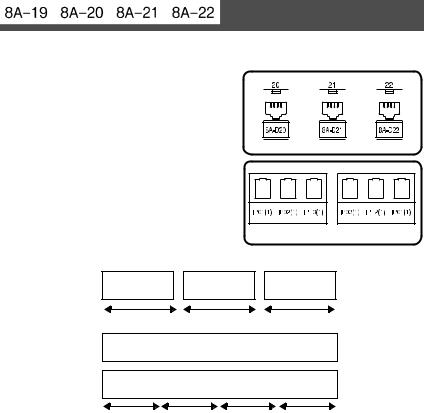
Port and Panel1 Modes
Labels printed using these Label Type modes can be used to identify various components or panels.
With the Port Label Type mode, each block of the text is printed on a separate label, making these labels useful for identifying different components or ports that are not equally spaced.
With the Panel1 Label Type mode, all blocks of the text are evenly spaced on a single label, making this label useful for a row of equally spaced switches, fuses or connectors on a patch panel. In addition, the text blocks can be printed in the order that they were typed in or in the opposite order.
IN ORDER |
REVERSE |
Port
Block length |
Block length |
Block length |
Panel1 (PRINT set to
IN ORDER)
Panel1 (PRINT set to REVERSE)
Block length Block length Block length |
Block length |
After selecting the PORT or PANEL1 Label Type mode, specify the length of each text block or label, and select a frame style if desired. For the PANEL1 Label Type mode, select whether the text blocks are printed in the order that they were typed in or in the reverse order.
16

●BL. LEN. (block length): * For the PORT Label Type mode:
20.0to 200.0 mm
Default: 30.0 mm
* For the PANEL1 Label Type mode: 6.0 to 200.0 mm
Default: 30.0 mm
● FRAME: |
* For the PORT Label Type mode: |
||||||||||||||||||
|
OFF, 1 |
|
|
|
, 2 |
|
|
|
, 3 |
, 4 |
|||||||||
|
|
|
|
|
|
|
|||||||||||||
|
|
|
|
|
|
|
|
|
|
|
|
|
|
|
|
|
|
||
|
Default: OFF |
|
|
|
|
|
|
|
|
|
|||||||||
|
* For the PANEL1 Label Type mode: |
||||||||||||||||||
|
OFF, 1 |
|
|
, 2 |
|
|
|
, 3 |
|
|
|
|
, |
||||||
|
|
|
|
|
|
|
|||||||||||||
|
4 |
|
|
|
|
, 5 |
|
|
|
|
, 6 |
|
|
, |
|
|
|
||
|
7 |
|
|
|
, 8 |
|
|
|
|
, 9 |
|
|
|
|
|
|
|
||
|
Default: OFF |
|
|
|
|
|
|
|
|
|
|||||||||
● PRINT (print order): |
IN ORDER, REVERSE |
|
|
|
|
|
|||||||||||||
|
Default: IN ORDER |
|
|
|
|
|
|
|
|
|
|||||||||
For these types of labels, we recommend using Strong Adhesive Tape.
The PRINT parameter is only available with the PANEL1 Label Type mode.
By using the Numbering function with the PANEL1 Label Type mode, a single label containing multiple blocks of ascending characters can easily be created, for example, to label patch panels as shown above. (For details on the Numbering function, refer to
Printing multiple copies with incremental characters on page 36.)
Panel2 Mode
Specifying a fixed length for each block makes this label useful for a row of switches (for example, in a switchboard) or a patch panel. In addition, the text blocks can be printed in the order that they were typed in or in the opposite order, or the text can be printed rotated 90°.
Panel2
|
Block 1 |
Block 2 |
|
Block 3 |
|
|
|
|
|
|
|
Block length |
Block length |
|
Block length |
||
(Length × Multiple) |
(Length × Multiple) |
(Length × Multiple) |
|||
Label Type Modes
17
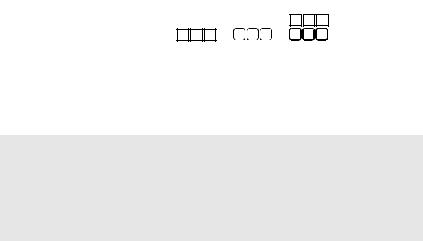
● BLOCK: |
1 to 50 blocks |
|
|
|
|
|
|
|
|
||||||||
|
Default: 1 |
|
|
|
|
|
|
|
|
|
|
|
|
|
|||
LENGTH: |
6.0 to 200.0 mm |
|
|
|
|
|
|
|
|
||||||||
|
Default: 17.5mm |
|
|
|
|
|
|
|
|
||||||||
MULTIPLE: |
x1 to x9 |
|
|
|
|
|
|
|
|
|
|
|
|
|
|||
|
Default: 1 |
|
|
|
|
|
|
|
|
|
|
|
|
|
|||
● FRAME: |
OFF, 1 |
|
|
, 2 |
|
|
|
, 3 |
|
|
|
|
, |
||||
|
|
|
|
|
|
||||||||||||
|
4 |
|
|
|
, 5 |
|
|
|
, 6 |
|
, |
|
|
|
|||
|
7 |
|
|
|
, 8 |
|
|
|
, 9 |
|
|
|
|
|
|
||
|
Default: OFF |
|
|
|
|
|
|
|
|
||||||||
● PRINT: |
IN ORDER, REVERSE |
|
|
|
|
|
|||||||||||
|
Default: IN ORDER |
|
|
|
|
|
|
|
|
||||||||
● ROTATE: |
OFF, ON |
|
|
|
|
|
|
|
|
|
|
|
|
|
|||
|
Default: OFF |
|
|
|
|
|
|
|
|
||||||||
The number of blocks can be specified or changed only with the BLOCK parameter. Text blocks cannot be added or deleted in any other way.
If the number of blocks specified in the PANEL2 Label Type mode is less than the number of text blocks that have already been entered, entered text blocks are deleted. If the specified number of blocks is greater than the number of entered text blocks, text blocks are added.
For these types of labels, we recommend using Strong Adhesive Tape.
18
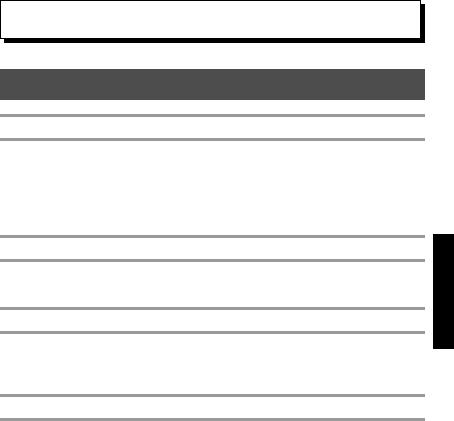
3 Basic Functions
Performing Basic Operations
Choosing functions, parameters, settings and groups
●If “WX” appears, press l to select the previous item or r to select the next item.
●If “ ST ” appears, press uto select the previous item or d to select the next item.
Choosing the default setting
● To select the default setting of a function or parameter, press e.
Confirming a choice
●To select an item from a list, to apply a selected setting, or to answer “yes”, press n.
Cancelling a choice
●To quit a function and return to the previous display without changing the text, or to answer “no”, press b.
Basic Functions
19
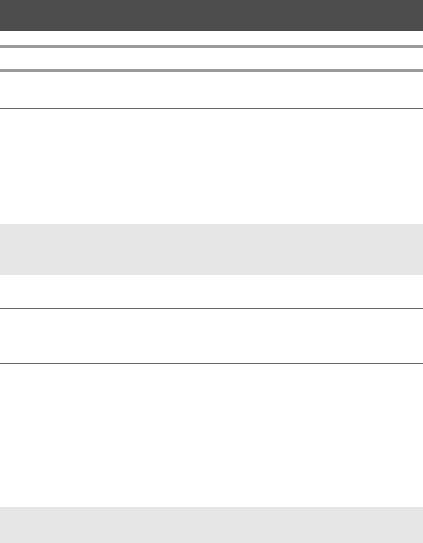
Inputting Label Data
Entering and editing text
Entering characters
●To type a lowercase letter, a number, a comma or a period, simply press the key for that character.
●To type an uppercase letter, press h to enter Shift mode, and then press the applicable letter.
●To type uppercase letters continuously, press g, then h to enter Caps mode, and then type.
To exit Shift mode without typing a letter, press h.
To exit Caps mode, press g, then h.
To type a lowercase letter in Caps mode, press h, then the applicable letter.
Entering spaces
● To add a blank space to the text, press e.
Moving the cursor
Move the cursor in order to review and edit the text, or you can select the various functions and settings.
●To move the cursor left, right, up or down, press l, r, u or d.
●To move the cursor to the beginning of the current line of text, press g, then l.
●To move the cursor to the end of the current line of text, press g, then r.
●To move the cursor to the beginning of the entered text, press g, then u.
●To move the cursor to the end of the entered text, press g, then d.
To move the cursor several characters or lines at once, hold down l, r, uor d.
20
